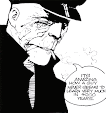With visions of Mr Alternative Car Park in mind, we've
traditionally steered clear of 'dance theatre' down the years.
So however qualified I might be to comment on drama, I really lack the critical vocabulary to say much about dance.
So however qualified I might be to comment on drama, I really lack the critical vocabulary to say much about dance.
However, I
was so intrigued by Matthew Bourne's Play Without Words, currently enjoying a revival at Sadler's Wells, that I
thought I'd make the effort.
The play, originally commissioned in 2002 by the National Theatre, draws heavily on the 1962 film The Servant (written by Harold Pinter and directed by Joseph Losey), in which a wealthy young Londoner (James Fox) has his world turned upside-down by the machinations of his new manservant (Dirk Bogarde).
The play, originally commissioned in 2002 by the National Theatre, draws heavily on the 1962 film The Servant (written by Harold Pinter and directed by Joseph Losey), in which a wealthy young Londoner (James Fox) has his world turned upside-down by the machinations of his new manservant (Dirk Bogarde).
Bourne's
version largely follows the original, as dapper Chelsea chap Anthony hires the dourly
malevolent Prentice, who brings with him a housemaid, Sheila. Anthony also has a sophisticated
but snotty fiancée, Glenda, who finds herself drawn into the conflict.
However, in
tackling the story for a wordless dance piece, Bourne introduces one amazing
idea that totally defines the production.
Instead of one actor/dancer playing each part, there are two or often three in most scenes.
Instead of one actor/dancer playing each part, there are two or often three in most scenes.
As the
action plays out, we therefore see simultaneous variations, some subtle and
some more dramatic, that lead to a range of outcomes – a kind of 4D narrative
cubism.
Sometimes
the parallel selves seem aware of each other. During a very steamy scene on the
kitchen table between Anthony and Sheila, their doppelgangers look on in shock
through a nearby window.
The device
is also used humorously, as when one Prentice dresses one Anthony for the day,
while another undresses his boss in parallel.
It comes to
its natural conclusion at the clanging climax of the play, when the power shift
between Anthony and Prentice plays out in three very different ways.
As I said
above, I'm no dance expert. However, even I could tell that the show was stolen
by Jonathan Ollivier, who flung himself around impressively as Speight, an edgy
Angry-Young-Man friend of Anthony who also plays a part in the destruction of
the status quo.
The cool
jazzy score by Terry Davies is also variously evocative and electrifying, while
Lez Brotherston's versatile set creates a host of locations, including Anthony's
home, a swinging jazz club and the then-seediness of the famous Salisbury pub on St Martin's
Lane.
I usually
find dance – or 'physical theatre' more generally – a bit off-putting, but
Matthew Bourne and his company deliver Play
Without Words with such verve and vision that it's impossible to resist.





No comments:
Post a Comment